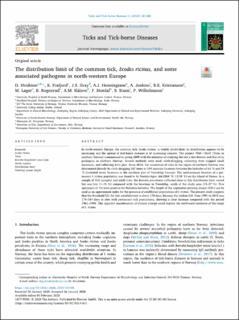| dc.contributor.author | Hvidsten, Dag | |
| dc.contributor.author | Frafjord, Karl | |
| dc.contributor.author | Gray, Jeremy S. | |
| dc.contributor.author | Henningsson, Anna Jonsson | |
| dc.contributor.author | Jenkins, Andrew | |
| dc.contributor.author | Kristiansen, Bjørn Erik | |
| dc.contributor.author | Lager, Malin | |
| dc.contributor.author | Rognerud, Bjørg | |
| dc.contributor.author | Slåtsve, Arne Martin | |
| dc.contributor.author | Stordal, Frode | |
| dc.contributor.author | Stuen, Snorre | |
| dc.contributor.author | Wilhelmsson, Peter | |
| dc.date.accessioned | 2020-11-17T14:18:22Z | |
| dc.date.available | 2020-11-17T14:18:22Z | |
| dc.date.created | 2020-05-23T17:09:30Z | |
| dc.date.issued | 2020 | |
| dc.identifier.citation | Ticks and Tick-borne Diseases. 2020, 11(4) . | en_US |
| dc.identifier.issn | 1877-959X | |
| dc.identifier.uri | https://hdl.handle.net/11250/2688295 | |
| dc.description.abstract | In north-western Europe, the common tick, Ixodes ricinus, is widely established, its distribution appears to be increasing and the spread of tick-borne diseases is of increasing concern. The project ‘Flått i Nord’ (Ticks in northern Norway) commenced in spring 2009 with the intention of studying the tick’s distribution and that of its pathogens in northern Norway. Several methods were used: cloth-dragging, collecting from trapped small mammals, and collecting from pets. Since 2010, the occurrence of ticks in the region of northern Norway was determined directly by cloth-dragging 167 times in 109 separate locations between the latitudes of 64 °N and 70 °N (included seven locations in the northern part of Trøndelag County). The northernmost location of a permanent I. ricinus population was found to be Nordøyvågen (66.2204 °N, 12.59 °E) on the Island of Dønna. In a sample of 518 nymphal and adult ticks, the Borrelia prevalence collected close to this distribution limit varied but was low (1–15 %) compared with the locations in Trøndelag, south of the study area (15–27 %). Five specimens (1 %) were positive for Rickettsia helvetica. The length of the vegetation growing season (GSL) can be used as an approximate index for the presence of established populations of I. ricinus. The present study suggests that the threshold GSL for tick establishment is about 170 days, because the median GSL from 1991 to 2015 was 174–184 days at sites with permanent tick populations, showing a clear increase compared with the period 1961–1990. This apparent manifestation of climate change could explain the northward extension of the range of I. ricinus. | en_US |
| dc.language.iso | eng | en_US |
| dc.rights | Attribution-NonCommercial-NoDerivatives 4.0 Internasjonal | * |
| dc.rights.uri | http://creativecommons.org/licenses/by-nc-nd/4.0/deed.no | * |
| dc.title | The distribution limit of the common tick, Ixodes ricinus, and some associated pathogens in north-western Europe | en_US |
| dc.type | Peer reviewed | en_US |
| dc.type | Journal article | en_US |
| dc.description.version | publishedVersion | en_US |
| dc.source.pagenumber | 10 | en_US |
| dc.source.volume | 11 | en_US |
| dc.source.journal | Ticks and Tick-borne Diseases | en_US |
| dc.source.issue | 4 | en_US |
| dc.identifier.doi | 10.1016/j.ttbdis.2020.101388 | |
| dc.identifier.cristin | 1812241 | |
| dc.source.articlenumber | 101388 | en_US |
| cristin.ispublished | true | |
| cristin.fulltext | original | |
| cristin.qualitycode | 1 | |

